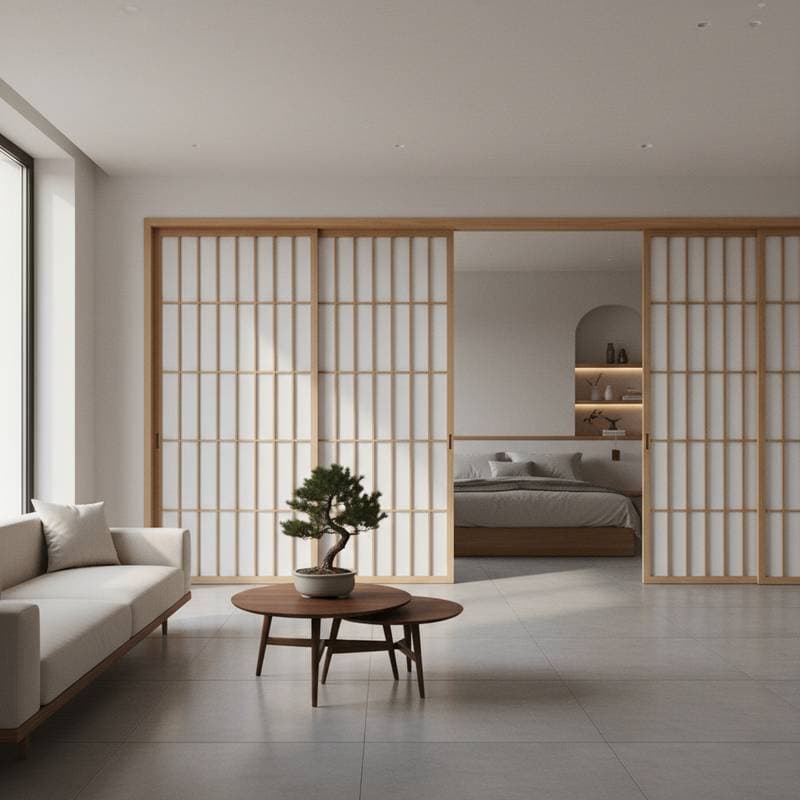Japandi Entryways: 2025's Zen-Minimalist Must-Have
Japandi design emerges as a prominent trend for homeowners who desire calm and functional beauty in their interiors. This hybrid style merges Japanese simplicity with Scandinavian warmth, resulting in spaces that balance minimalism and invitation. The entryway exemplifies this approach, establishing the overall tone for the home from the first point of arrival.
Average Costs to Create a Japandi Entryway
A Japandi-style entryway generally ranges from $3,000 to $8,000 in total cost. This figure varies based on the space's dimensions, chosen materials, and the decision to engage professional contractors or handle elements independently. Investments in bespoke millwork or high-end wood doors can elevate expenses to approximately $10,000, whereas compact areas using off-the-shelf furnishings and straightforward finishes align with the lower spectrum.
| Feature or Material | Average Cost Range | Notes |
|---|---|---|
| Solid wood entry door | $1,500 to $4,000 | Oak, ash, or walnut provide the desired warm tones |
| Built-in shoe storage | $800 to $2,200 | Custom carpentry enhances organizational efficiency |
| Natural stone or tile flooring | $1,000 to $3,000 | Slate and limestone offer texture alongside durability |
| Lighting upgrades | $250 to $800 | Soft LED or pendant fixtures contribute to mood enhancement |
| Minimalist furniture | $400 to $1,000 | Benches, trays, and small tables feature natural finishes |
These estimates encompass both labor and materials. Local market differences and pre-existing structural elements may adjust the final amount upward or downward.
Key Design Principles for a Japandi Entryway
Japandi entryways prioritize balance, function, and serenity. Designers aim to craft a smooth transition from exterior to interior environments while minimizing visual clutter. Smooth wooden surfaces, precise lines, and natural textures dominate the aesthetic.
- Natural materials: Select solid woods, stone, and woven elements to emphasize organic warmth. Light oak or ash pairings with neutral walls create harmony.
- Muted color palette: Employ soft whites, warm taupes, and subtle grays. Charcoal or black accents introduce contrast without dominance.
- Functional simplicity: Ensure each item fulfills a practical role. Incorporate storage benches, wall-mounted hooks, and streamlined shelving to promote tidiness.
- Soft lighting: Utilize warm, diffused illumination to foster tranquility. Steer clear of intense overhead sources.
Interior designer Lena Morita of Kyoto Interiors states, "The Japandi entryway succeeds when it feels intentional but effortless. Each element should contribute to calmness and flow."
Factors That Influence Cost and Complexity
The overall expenditure hinges on the entryway's scale and renovation depth. Updating flooring or lighting incurs moderate additional costs, but bespoke storage solutions or artisanal wood doors extend both budget and project duration.
Pre-existing layouts impact pricing significantly. Structures in older residences might necessitate floor re-leveling or electrical modifications to integrate new features. When employing a licensed contractor, labor typically constitutes 35 to 50 percent of the total outlay.
Choosing the Right Entry Door
The entry door functions as the central element in a Japandi entrance. Opt for solid wood or veneer options featuring uncomplicated paneling and matte surfaces. Refrain from elaborate ornamentation or prominent metal hardware. A straightforward wood door with vertical grain imparts inherent texture and composure.
| Door Type | Cost Range | Description |
|---|---|---|
| Solid wood slab | $2,000 to $4,000 | Offers superior durability, suited for tailored finishes |
| Wood veneer | $800 to $1,800 | Provides economical choice with uniform visual appeal |
| Composite wood | $600 to $1,200 | Resists warping, delivers acceptable aesthetic standards |
Incorporating frosted glass panels allows natural light entry while preserving privacy, aligning with core Japandi tenets.
Lighting and Finishing Touches
Achieve the ideal ambiance through warm, multi-layered lighting. Wall sconces, recessed options, or pendant lamps crafted from bamboo or linen finalize the composition. Install dimmers to modulate intensity across daily cycles, adding versatility to the space.
Subtle additions like a woven rug, ceramic planter, or artisanal tray infuse texture judiciously. Restrict accessories to essentials, preserving the serene essence of Japandi design.
Maintaining Your Japandi Entryway
Preserve the entryway's appeal with routine care tailored to natural materials. Dust wooden surfaces weekly using a soft cloth to avoid scratches, and apply wood conditioner biannually for sustained warmth. For stone or tile floors, employ pH-neutral cleaners to maintain their subtle patina without chemical residue.
Address lighting fixtures by wiping fixtures gently and replacing bulbs as needed to ensure consistent soft glow. Periodically reorganize storage to prevent accumulation, upholding the minimalist ethos. These practices extend the design's longevity and reinforce daily tranquility.
Embracing Calm Transitions in Your Home
A Japandi entryway extends beyond guest greetings; it instills serenity with every homecoming. Through emphasis on natural elements, deliberate illumination, and purposeful arrangements, even modest foyers evolve into restorative havens. This investment yields enduring peace and refined style at the threshold.






